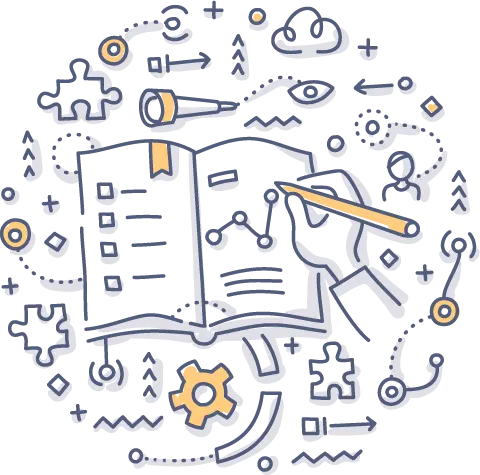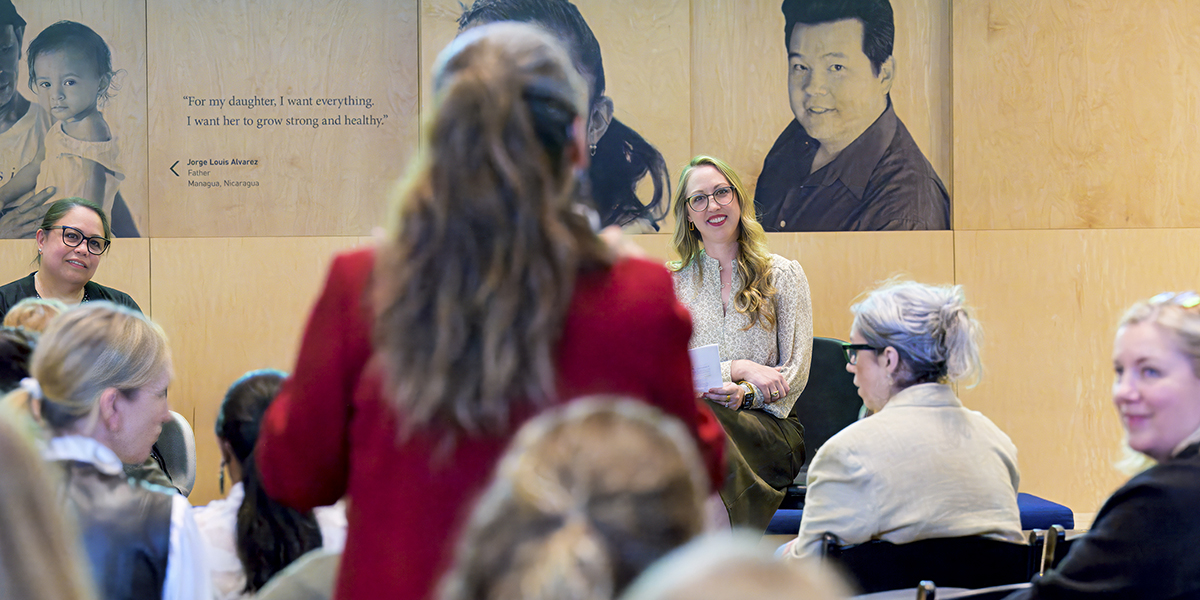Written by: Barbara Visser – Illustration by: koctia
My journey as an entrepreneur began in the early months of the COVID-19 pandemic. My days were busy with long to-do lists juggling between family and work, yet I struggled to know if my activities were driving true value toward my new business. For the previous 20 years, within a large corporate environment, I generally worked within structured goals set by the management chain above me. Now, as the business owner, how would I set goals, prioritize activity, and measure meaningful progress? Especially when working alone, the missing managerial framework with its external feedback and validation fed my doubts, increased my distractibility, and decreased my self-confidence with echoes of “am I doing this right?”
Objectives and Key Results: A method for practical inspiration
I needed a structure that was both inspiring and practical. As an experiment, I began to apply the planning framework known as Objectives and Key Results (OKRs), an approach used frequently by corporations to align efforts across large organizations. “Objectives and key results are the yin and yang of goal setting—principle and practice, vision and execution. Objectives are the stuff of inspiration and far horizons. Key results are more earthbound and metric-driven,” writes John Doerr in Measure What Matters.
Born at Intel in the 1970s, OKRs have been adopted broadly by technology firms and other corporations. OKRs generally pair both top-down and bottom-up articulation of inspirational Objectives (visionary intention of where you want to go) with a small set of Key Results (quantifiable outcomes that measure success). They combine critical thinking with ongoing practice to manage priorities, stretch beyond pre-conceived limits, and identify the next immediate steps toward the big picture. Focusing on fewer things, rather than more, teams generally select three to five objectives, each measured by four to six key results that include a quantifiable number.
In his book, Innovation and Entrepreneurship, Peter Drucker writes, “Entrepreneurship is neither a science nor an art. It is a practice.” I gained value from the simple goal-setting practice of OKRs that spoke to both my head AND my heart, while it informed my hands in daily work. OKR best practices also include sustained attention during time-bound sprints, pausing for regular reflection, adapting to new information, and resetting stretch goals on a quarterly, bi-annual, or annual basis. Through this sustained focus, “The process reminds you what to do, even when you don’t feel like doing it.” (Christina Wodtke, Radical Focus: Achieving Your Most Important Goals with Objectives and Key Results (OKRs).
I began using a simple spreadsheet and drafted three Objectives that spoke to the big “why” for my business vision, and then described specific quantifiable outcomes that would help me measure progress toward each objective. My first lists were long and read like a task list, not ideal for the radical focus of OKRs. I explored these questions to help me pare down my KRs:
What can I not afford to lose sight of?
What absolutely must get done in the next three months?
What blockers can I fix first, to accelerate progress later?
What matters most?
Each Monday, I reviewed my OKRs (like many teams do at corporations in a weekly staff meeting), which helped me set the course for priority activities during the week. On Fridays, I documented progress made toward each of the key results. At the end of the quarter, I paused to reflect on wins, lessons, and gaps, and then refreshed my key results for the next quarter. Using OKRs allowed me to build structure into my small business and create clarity in the chaos of launching a new business.
OKR Impact for Entrepreneurs
Using OKRs for my new business provided me with structure, motivation, and momentum to stay focused even when I got discouraged, distracted, or blocked.
- Energize through inspiration. OKRs help clarify the deep value behind your business, articulating the big “why” behind a goal or activity. Writing the dream in concrete terms validates the vision and can inspire you when things get rough.
- Quiet inner critics. Using quantifiable key results reduces the volume of saboteur voices that tempt you to play small and undervalue yourself and your business. OKRs provide a neutralizing framework to reduce imposter syndrome and boost confidence.
- Accelerate progress. Radical clarity and intentional focus boosts speed and power for what matters most. OKRS empower your choice to tackle first things first, providing the opportunity to deliver value sooner and remove roadblocks to progress in future quarters.
- Achieve more. Imagining the best possible outcome creates a slightly uncomfortable stretch to dream bigger. When designing Key Results, you ask “what would be great?” not “what would be safe?” As John Doerr writes, the OKR framework “expands our limits. It moves us to strive for what might seem beyond our reach.”
- Sustain focus. The practice of OKRS creates a helpful rhythm of plan/act/review. Everything is an experiment yet measured. You can see your work accrue to your goals and train your focus on results rather than activity.
- Empower prioritization and accountability. The to-do lists of a new business owner are dauntingly long and dispersed. OKRs demand focused prioritization, quantifiable results, and a growth mindset to learn while you work. OKRs empower flexible accountability, not flakiness, as you consciously make trade-offs, course correct, say no, say yes, and set boundaries.
- Celebrate visible progress. Key Results define what it looks like to move from the current to state to the desired state. Progress is made visible. Checking in regularly allows you to build time to pause and celebrate results, which can be easy to skip when working by yourself.
OKRs can inspire and empower people who have great new ideas to help make them real in the world. In her blog, the CEO and Co-Founder of WorkBoard, Deidre Paknad calls us to, “Have an unwavering focus on creating value for customers and the organization above all else. Work with purpose and passion every day.” The Difference Between Dreamers and Doers | WorkBoard Blog.
Tips for building OKRs into your business operations
Based on my experiment using OKRs to manage and nurture my small business, here are tips for building Objectives and Key Results into your entrepreneurial operations.
- Articulate the vision of where you want to go and the key outcomes that will demonstrate success by writing three to five Objectives, each with four to six Key Results. For reference, WorkBoard provides asimple definition of well-crafted OKRs with a variety of examples.
- Define a weekly rhythm to prioritize aligned activity and document progress. Set your plans for the week on Monday, working from your OKR priorities. Celebrate on Fridays, updating progress on key results that will inform and allow you to adjust for what is needed next. It may help you uncover roadblocks or dependencies and can help you focus your follow up.
- Hold your own quarterly reviews. Celebrate wins, acknowledge lessons, and refine your OKRs to reflect what will you start, stop, or continue with updated targets for the next period.
- Ruthlessly prioritize and focus on fewer outcomes at one time. You can keep a backlog of items that do not make the list for this quarter and incorporate them in the future.
- Imagine the best possible stretch rather than playing it safe. What would be an AMAZING result that brings your vision to life faster than you imagined?
I dreamed of creating my business off and on for years, jotting down notes and ideas spread across paper and OneNote. When the moment arrived to fully commit, I needed a framework to organize my thoughts and prioritize my actions. “Ideas are easier to come up with than you think. What’s hard — really hard — is moving from an idea to reality,” writes Christina Wodtke in Radical Focus. “You need a system to keep you — and your team— aimed at your goal when the world seems determined to throw shiny objects at you.” For me, OKRs offered an effective planning approach that included both inspiration and accountability, dreaming and doing, vision and results, which allowed me to build and nurture a strong business foundation as an entrepreneur.
Next Steps
Lions & Tigers supports organizations with OKR training, development and sustained accountability coaching in 1:1 and 1:many formats. For more information about how OKR training and coaching services or exec coaching accelerate the way your team works and achieves success, contact us here.
 Barbara blends her experience in coaching, business, and communication as an executive coach and OKR consultant with Lions & Tigers. In 20 years at Microsoft, she built expertise in executive communication, employee engagement, and program management. She helps leaders gain clarity, stay motivated, and commit to actions that honor who they are as both people and professionals. She is a mother of two, Associate Certified Coach (ACC), Certified Professional Co-Active Coach (CPCC), OKR Expert, and Distinguished Toastmaster (DTM).
Barbara blends her experience in coaching, business, and communication as an executive coach and OKR consultant with Lions & Tigers. In 20 years at Microsoft, she built expertise in executive communication, employee engagement, and program management. She helps leaders gain clarity, stay motivated, and commit to actions that honor who they are as both people and professionals. She is a mother of two, Associate Certified Coach (ACC), Certified Professional Co-Active Coach (CPCC), OKR Expert, and Distinguished Toastmaster (DTM).








0 Comments